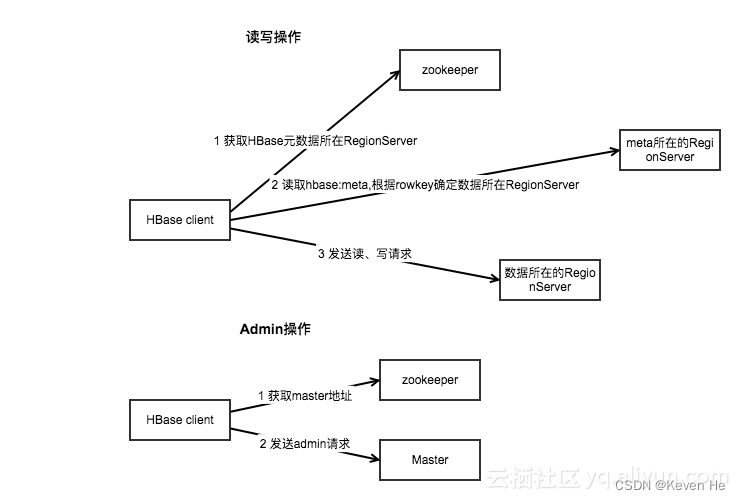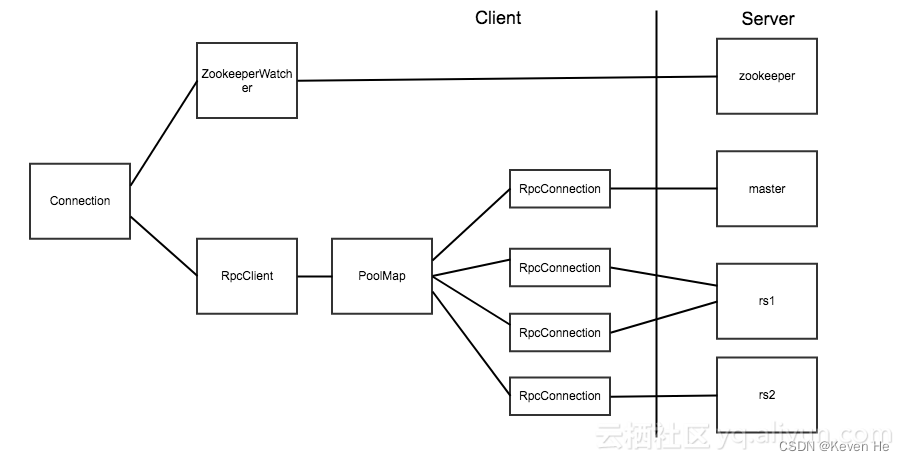一、简述
截至到目前 (2019.04),HBase 有两个主要的版本,分别是 1.x 和 2.x ,两个版本的 Java API 有所不同,1.x 中某些方法在 2.x 中被标识为 @deprecated 过时。
同时你使用的客户端的版本必须与服务端版本保持一致,如果用 2.x 版本的客户端代码去连接 1.x 版本的服务端,会抛出 NoSuchColumnFamilyException 等异常。
二、Java API 1.x 基本使用
2.1 新建Maven工程,导入项目依赖
要使用 Java API 操作 HBase,需要引入 hbase-client。这里选取的 HBase Client 的版本为 1.2.0。
<dependency>
<groupId>org.apache.hbase</groupId>
<artifactId>hbase-client</artifactId>
<version>1.2.0</version>
</dependency>
2.2 API 基本使用
public class HBaseUtils {
private static Connection connection;
static {
Configuration configuration = HBaseConfiguration.create();
configuration.set("hbase.zookeeper.property.clientPort", "2181");
// 如果是集群 则主机名用逗号分隔
configuration.set("hbase.zookeeper.quorum", "hadoop001");
try {
connection = ConnectionFactory.createConnection(configuration);
} catch (IOException e) {
e.printStackTrace();
}
}
/**
* 创建 HBase 表
*
* @param tableName 表名
* @param columnFamilies 列族的数组
*/
public static boolean createTable(String tableName, List<String> columnFamilies) {
try {
HBaseAdmin admin = (HBaseAdmin) connection.getAdmin();
if (admin.tableExists(tableName)) {
return false;
}
HTableDescriptor tableDescriptor = new HTableDescriptor(TableName.valueOf(tableName));
columnFamilies.forEach(columnFamily -> {
HColumnDescriptor columnDescriptor = new HColumnDescriptor(columnFamily);
columnDescriptor.setMaxVersions(1);
tableDescriptor.addFamily(columnDescriptor);
});
admin.createTable(tableDescriptor);
} catch (IOException e) {
e.printStackTrace();
}
return true;
}
/**
* 删除 hBase 表
*
* @param tableName 表名
*/
public static boolean deleteTable(String tableName) {
try {
HBaseAdmin admin = (HBaseAdmin) connection.getAdmin();
// 删除表前需要先禁用表
admin.disableTable(tableName);
admin.deleteTable(tableName);
} catch (Exception e) {
e.printStackTrace();
}
return true;
}
/**
* 插入数据
*
* @param tableName 表名
* @param rowKey 唯一标识
* @param columnFamilyName 列族名
* @param qualifier 列标识
* @param value 数据
*/
public static boolean putRow(String tableName, String rowKey, String columnFamilyName, String qualifier,
String value) {
try {
Table table = connection.getTable(TableName.valueOf(tableName));
Put put = new Put(Bytes.toBytes(rowKey));
put.addColumn(Bytes.toBytes(columnFamilyName), Bytes.toBytes(qualifier), Bytes.toBytes(value));
table.put(put);
table.close();
} catch (IOException e) {
e.printStackTrace();
}
return true;
}
/**
* 插入数据
*
* @param tableName 表名
* @param rowKey 唯一标识
* @param columnFamilyName 列族名
* @param pairList 列标识和值的集合
*/
public static boolean putRow(String tableName, String rowKey, String columnFamilyName, List<Pair<String, String>> pairList) {
try {
Table table = connection.getTable(TableName.valueOf(tableName));
Put put = new Put(Bytes.toBytes(rowKey));
pairList.forEach(pair -> put.addColumn(Bytes.toBytes(columnFamilyName), Bytes.toBytes(pair.getKey()), Bytes.toBytes(pair.getValue())));
table.put(put);
table.close();
} catch (IOException e) {
e.printStackTrace();
}
return true;
}
/**
* 根据 rowKey 获取指定行的数据
*
* @param tableName 表名
* @param rowKey 唯一标识
*/
public static Result getRow(String tableName, String rowKey) {
try {
Table table = connection.getTable(TableName.valueOf(tableName));
Get get = new Get(Bytes.toBytes(rowKey));
return table.get(get);
} catch (IOException e) {
e.printStackTrace();
}
return null;
}
/**
* 获取指定行指定列 (cell) 的最新版本的数据
*
* @param tableName 表名
* @param rowKey 唯一标识
* @param columnFamily 列族
* @param qualifier 列标识
*/
public static String getCell(String tableName, String rowKey, String columnFamily, String qualifier) {
try {
Table table = connection.getTable(TableName.valueOf(tableName));
Get get = new Get(Bytes.toBytes(rowKey));
if (!get.isCheckExistenceOnly()) {
get.addColumn(Bytes.toBytes(columnFamily), Bytes.toBytes(qualifier));
Result result = table.get(get);
byte[] resultValue = result.getValue(Bytes.toBytes(columnFamily), Bytes.toBytes(qualifier));
return Bytes.toString(resultValue);
} else {
return null;
}
} catch (IOException e) {
e.printStackTrace();
}
return null;
}
/**
* 检索全表
*
* @param tableName 表名
*/
public static ResultScanner getScanner(String tableName) {
try {
Table table = connection.getTable(TableName.valueOf(tableName));
Scan scan = new Scan();
return table.getScanner(scan);
} catch (IOException e) {
e.printStackTrace();
}
return null;
}
/**
* 检索表中指定数据
*
* @param tableName 表名
* @param filterList 过滤器
*/
public static ResultScanner getScanner(String tableName, FilterList filterList) {
try {
Table table = connection.getTable(TableName.valueOf(tableName));
Scan scan = new Scan();
scan.setFilter(filterList);
return table.getScanner(scan);
} catch (IOException e) {
e.printStackTrace();
}
return null;
}
/**
* 检索表中指定数据
*
* @param tableName 表名
* @param startRowKey 起始 RowKey
* @param endRowKey 终止 RowKey
* @param filterList 过滤器
*/
public static ResultScanner getScanner(String tableName, String startRowKey, String endRowKey,
FilterList filterList) {
try {
Table table = connection.getTable(TableName.valueOf(tableName));
Scan scan = new Scan();
scan.setStartRow(Bytes.toBytes(startRowKey));
scan.setStopRow(Bytes.toBytes(endRowKey));
scan.setFilter(filterList);
return table.getScanner(scan);
} catch (IOException e) {
e.printStackTrace();
}
return null;
}
/**
* 删除指定行记录
*
* @param tableName 表名
* @param rowKey 唯一标识
*/
public static boolean deleteRow(String tableName, String rowKey) {
try {
Table table = connection.getTable(TableName.valueOf(tableName));
Delete delete = new Delete(Bytes.toBytes(rowKey));
table.delete(delete);
} catch (IOException e) {
e.printStackTrace();
}
return true;
}
/**
* 删除指定行的指定列
*
* @param tableName 表名
* @param rowKey 唯一标识
* @param familyName 列族
* @param qualifier 列标识
*/
public static boolean deleteColumn(String tableName, String rowKey, String familyName,
String qualifier) {
try {
Table table = connection.getTable(TableName.valueOf(tableName));
Delete delete = new Delete(Bytes.toBytes(rowKey));
delete.addColumn(Bytes.toBytes(familyName), Bytes.toBytes(qualifier));
table.delete(delete);
table.close();
} catch (IOException e) {
e.printStackTrace();
}
return true;
}
}
2.3 单元测试
以单元测试的方式对上面封装的 API 进行测试。
public class HBaseUtilsTest {
private static final String TABLE_NAME = "class";
private static final String TEACHER = "teacher";
private static final String STUDENT = "student";
@Test
public void createTable() {
// 新建表
List<String> columnFamilies = Arrays.asList(TEACHER, STUDENT);
boolean table = HBaseUtils.createTable(TABLE_NAME, columnFamilies);
System.out.println("表创建结果:" + table);
}
@Test
public void insertData() {
List<Pair<String, String>> pairs1 = Arrays.asList(new Pair<>("name", "Tom"),
new Pair<>("age", "22"),
new Pair<>("gender", "1"));
HBaseUtils.putRow(TABLE_NAME, "rowKey1", STUDENT, pairs1);
List<Pair<String, String>> pairs2 = Arrays.asList(new Pair<>("name", "Jack"),
new Pair<>("age", "33"),
new Pair<>("gender", "2"));
HBaseUtils.putRow(TABLE_NAME, "rowKey2", STUDENT, pairs2);
List<Pair<String, String>> pairs3 = Arrays.asList(new Pair<>("name", "Mike"),
new Pair<>("age", "44"),
new Pair<>("gender", "1"));
HBaseUtils.putRow(TABLE_NAME, "rowKey3", STUDENT, pairs3);
}
@Test
public void getRow() {
Result result = HBaseUtils.getRow(TABLE_NAME, "rowKey1");
if (result != null) {
System.out.println(Bytes
.toString(result.getValue(Bytes.toBytes(STUDENT), Bytes.toBytes("name"))));
}
}
@Test
public void getCell() {
String cell = HBaseUtils.getCell(TABLE_NAME, "rowKey2", STUDENT, "age");
System.out.println("cell age :" + cell);
}
@Test
public void getScanner() {
ResultScanner scanner = HBaseUtils.getScanner(TABLE_NAME);
if (scanner != null) {
scanner.forEach(result -> System.out.println(Bytes.toString(result.getRow()) + "->" + Bytes
.toString(result.getValue(Bytes.toBytes(STUDENT), Bytes.toBytes("name")))));
scanner.close();
}
}
@Test
public void getScannerWithFilter() {
FilterList filterList = new FilterList(FilterList.Operator.MUST_PASS_ALL);
SingleColumnValueFilter nameFilter = new SingleColumnValueFilter(Bytes.toBytes(STUDENT),
Bytes.toBytes("name"), CompareOperator.EQUAL, Bytes.toBytes("Jack"));
filterList.addFilter(nameFilter);
ResultScanner scanner = HBaseUtils.getScanner(TABLE_NAME, filterList);
if (scanner != null) {
scanner.forEach(result -> System.out.println(Bytes.toString(result.getRow()) + "->" + Bytes
.toString(result.getValue(Bytes.toBytes(STUDENT), Bytes.toBytes("name")))));
scanner.close();
}
}
@Test
public void deleteColumn() {
boolean b = HBaseUtils.deleteColumn(TABLE_NAME, "rowKey2", STUDENT, "age");
System.out.println("删除结果: " + b);
}
@Test
public void deleteRow() {
boolean b = HBaseUtils.deleteRow(TABLE_NAME, "rowKey2");
System.out.println("删除结果: " + b);
}
@Test
public void deleteTable() {
boolean b = HBaseUtils.deleteTable(TABLE_NAME);
System.out.println("删除结果: " + b);
}
}
三、Java API 2.x 基本使用
3.1 新建Maven工程,导入项目依赖
这里选取的 HBase Client 的版本为最新的 2.1.4。
<dependency>
<groupId>org.apache.hbase</groupId>
<artifactId>hbase-client</artifactId>
<version>2.1.4</version>
</dependency>
3.2 API 的基本使用
2.x 版本相比于 1.x 废弃了一部分方法,关于废弃的方法在源码中都会指明新的替代方法,比如,在 2.x 中创建表时:HTableDescriptor 和 HColumnDescriptor 等类都标识为废弃,取而代之的是使用 TableDescriptorBuilder 和 ColumnFamilyDescriptorBuilder 来定义表和列族。

以下为 HBase 2.x 版本 Java API 的使用示例:
public class HBaseUtils {
private static Connection connection;
static {
Configuration configuration = HBaseConfiguration.create();
configuration.set("hbase.zookeeper.property.clientPort", "2181");
// 如果是集群 则主机名用逗号分隔
configuration.set("hbase.zookeeper.quorum", "hadoop001");
try {
connection = ConnectionFactory.createConnection(configuration);
} catch (IOException e) {
e.printStackTrace();
}
}
/**
* 创建 HBase 表
*
* @param tableName 表名
* @param columnFamilies 列族的数组
*/
public static boolean createTable(String tableName, List<String> columnFamilies) {
try {
HBaseAdmin admin = (HBaseAdmin) connection.getAdmin();
if (admin.tableExists(TableName.valueOf(tableName))) {
return false;
}
TableDescriptorBuilder tableDescriptor = TableDescriptorBuilder.newBuilder(TableName.valueOf(tableName));
columnFamilies.forEach(columnFamily -> {
ColumnFamilyDescriptorBuilder cfDescriptorBuilder = ColumnFamilyDescriptorBuilder.newBuilder(Bytes.toBytes(columnFamily));
cfDescriptorBuilder.setMaxVersions(1);
ColumnFamilyDescriptor familyDescriptor = cfDescriptorBuilder.build();
tableDescriptor.setColumnFamily(familyDescriptor);
});
admin.createTable(tableDescriptor.build());
} catch (IOException e) {
e.printStackTrace();
}
return true;
}
/**
* 删除 hBase 表
*
* @param tableName 表名
*/
public static boolean deleteTable(String tableName) {
try {
HBaseAdmin admin = (HBaseAdmin) connection.getAdmin();
// 删除表前需要先禁用表
admin.disableTable(TableName.valueOf(tableName));
admin.deleteTable(TableName.valueOf(tableName));
} catch (Exception e) {
e.printStackTrace();
}
return true;
}
/**
* 插入数据
*
* @param tableName 表名
* @param rowKey 唯一标识
* @param columnFamilyName 列族名
* @param qualifier 列标识
* @param value 数据
*/
public static boolean putRow(String tableName, String rowKey, String columnFamilyName, String qualifier,
String value) {
try {
Table table = connection.getTable(TableName.valueOf(tableName));
Put put = new Put(Bytes.toBytes(rowKey));
put.addColumn(Bytes.toBytes(columnFamilyName), Bytes.toBytes(qualifier), Bytes.toBytes(value));
table.put(put);
table.close();
} catch (IOException e) {
e.printStackTrace();
}
return true;
}
/**
* 插入数据
*
* @param tableName 表名
* @param rowKey 唯一标识
* @param columnFamilyName 列族名
* @param pairList 列标识和值的集合
*/
public static boolean putRow(String tableName, String rowKey, String columnFamilyName, List<Pair<String, String>> pairList) {
try {
Table table = connection.getTable(TableName.valueOf(tableName));
Put put = new Put(Bytes.toBytes(rowKey));
pairList.forEach(pair -> put.addColumn(Bytes.toBytes(columnFamilyName), Bytes.toBytes(pair.getKey()), Bytes.toBytes(pair.getValue())));
table.put(put);
table.close();
} catch (IOException e) {
e.printStackTrace();
}
return true;
}
/**
* 根据 rowKey 获取指定行的数据
*
* @param tableName 表名
* @param rowKey 唯一标识
*/
public static Result getRow(String tableName, String rowKey) {
try {
Table table = connection.getTable(TableName.valueOf(tableName));
Get get = new Get(Bytes.toBytes(rowKey));
return table.get(get);
} catch (IOException e) {
e.printStackTrace();
}
return null;
}
/**
* 获取指定行指定列 (cell) 的最新版本的数据
*
* @param tableName 表名
* @param rowKey 唯一标识
* @param columnFamily 列族
* @param qualifier 列标识
*/
public static String getCell(String tableName, String rowKey, String columnFamily, String qualifier) {
try {
Table table = connection.getTable(TableName.valueOf(tableName));
Get get = new Get(Bytes.toBytes(rowKey));
if (!get.isCheckExistenceOnly()) {
get.addColumn(Bytes.toBytes(columnFamily), Bytes.toBytes(qualifier));
Result result = table.get(get);
byte[] resultValue = result.getValue(Bytes.toBytes(columnFamily), Bytes.toBytes(qualifier));
return Bytes.toString(resultValue);
} else {
return null;
}
} catch (IOException e) {
e.printStackTrace();
}
return null;
}
/**
* 检索全表
*
* @param tableName 表名
*/
public static ResultScanner getScanner(String tableName) {
try {
Table table = connection.getTable(TableName.valueOf(tableName));
Scan scan = new Scan();
return table.getScanner(scan);
} catch (IOException e) {
e.printStackTrace();
}
return null;
}
/**
* 检索表中指定数据
*
* @param tableName 表名
* @param filterList 过滤器
*/
public static ResultScanner getScanner(String tableName, FilterList filterList) {
try {
Table table = connection.getTable(TableName.valueOf(tableName));
Scan scan = new Scan();
scan.setFilter(filterList);
return table.getScanner(scan);
} catch (IOException e) {
e.printStackTrace();
}
return null;
}
/**
* 检索表中指定数据
*
* @param tableName 表名
* @param startRowKey 起始 RowKey
* @param endRowKey 终止 RowKey
* @param filterList 过滤器
*/
public static ResultScanner getScanner(String tableName, String startRowKey, String endRowKey,
FilterList filterList) {
try {
Table table = connection.getTable(TableName.valueOf(tableName));
Scan scan = new Scan();
scan.withStartRow(Bytes.toBytes(startRowKey));
scan.withStopRow(Bytes.toBytes(endRowKey));
scan.setFilter(filterList);
return table.getScanner(scan);
} catch (IOException e) {
e.printStackTrace();
}
return null;
}
/**
* 删除指定行记录
*
* @param tableName 表名
* @param rowKey 唯一标识
*/
public static boolean deleteRow(String tableName, String rowKey) {
try {
Table table = connection.getTable(TableName.valueOf(tableName));
Delete delete = new Delete(Bytes.toBytes(rowKey));
table.delete(delete);
} catch (IOException e) {
e.printStackTrace();
}
return true;
}
/**
* 删除指定行指定列
*
* @param tableName 表名
* @param rowKey 唯一标识
* @param familyName 列族
* @param qualifier 列标识
*/
public static boolean deleteColumn(String tableName, String rowKey, String familyName,
String qualifier) {
try {
Table table = connection.getTable(TableName.valueOf(tableName));
Delete delete = new Delete(Bytes.toBytes(rowKey));
delete.addColumn(Bytes.toBytes(familyName), Bytes.toBytes(qualifier));
table.delete(delete);
table.close();
} catch (IOException e) {
e.printStackTrace();
}
return true;
}
}
四、正确连接Hbase
在上面的代码中,在类加载时就初始化了 Connection 连接,并且之后的方法都是复用这个 Connection,这时我们可能会考虑是否可以使用自定义连接池来获取更好的性能表现?实际上这是没有必要的。
首先官方对于 Connection 的使用说明如下:
Connection Pooling For applications which require high-end multithreaded
access (e.g., web-servers or application servers that may serve many
application threads in a single JVM), you can pre-create a Connection,
as shown in the following example:
对于高并发多线程访问的应用程序(例如,在单个 JVM 中存在的为多个线程服务的 Web 服务器或应用程序服务器),
您只需要预先创建一个 Connection。例子如下:
// Create a connection to the cluster.
Configuration conf = HBaseConfiguration.create();
try (Connection connection = ConnectionFactory.createConnection(conf);
Table table = connection.getTable(TableName.valueOf(tablename))) {
// use table as needed, the table returned is lightweight
}
之所以能这样使用,这是因为 Connection 并不是一个简单的 socket 连接,接口文档 中对 Connection 的表述是:
A cluster connection encapsulating lower level individual connections to actual servers and a
connection to zookeeper. Connections are instantiated through the ConnectionFactory class.
The lifecycle of the connection is managed by the caller, who has to close() the connection
to release the resources.
Connection 是一个集群连接,封装了与多台服务器(Matser/Region Server)的底层连接以及与 zookeeper 的连接。
连接通过 ConnectionFactory 类实例化。连接的生命周期由调用者管理,调用者必须使用 close() 关闭连接以释放资源。
之所以封装这些连接,是因为 HBase 客户端需要连接三个不同的服务角色:
- Zookeeper :主要用于获取
meta表的位置信息,Master 的信息; - HBase Master :主要用于执行 HBaseAdmin 接口的一些操作,例如建表等;
- HBase RegionServer :用于读、写数据。

Connection 对象和实际的 Socket 连接之间的对应关系如下图:

上面两张图片引用自博客:连接 HBase 的正确姿势
在 HBase 客户端代码中,真正对应 Socket 连接的是 RpcConnection 对象。HBase 使用 PoolMap 这种数据结构来存储客户端到 HBase 服务器之间的连接。PoolMap 的内部有一个 ConcurrentHashMap 实例,其 key 是 ConnectionId(封装了服务器地址和用户 ticket),value 是一个 RpcConnection 对象的资源池。当 HBase 需要连接一个服务器时,首先会根据 ConnectionId 找到对应的连接池,然后从连接池中取出一个连接对象。
@InterfaceAudience.Private
public class PoolMap<K, V> implements Map<K, V> {
private PoolType poolType;
private int poolMaxSize;
private Map<K, Pool<V>> pools = new ConcurrentHashMap<>();
public PoolMap(PoolType poolType) {
this.poolType = poolType;
}
.....
HBase 中提供了三种资源池的实现,分别是 Reusable,RoundRobin 和 ThreadLocal。具体实现可以通 hbase.client.ipc.pool.type 配置项指定,默认为 Reusable。连接池的大小也可以通过 hbase.client.ipc.pool.size 配置项指定,默认为 1,即每个 Server 1 个连接。也可以通过修改配置实现:
config.set("hbase.client.ipc.pool.type",...);
config.set("hbase.client.ipc.pool.size",...);
connection = ConnectionFactory.createConnection(config);
由此可以看出 HBase 中 Connection 类已经实现了对连接的管理功能,所以我们不必在 Connection 上在做额外的管理。
另外,Connection 是线程安全的,但 Table 和 Admin 却不是线程安全的,因此正确的做法是一个进程共用一个 Connection 对象,而在不同的线程中使用单独的 Table 和 Admin 对象。Table 和 Admin 的获取操作 getTable() 和 getAdmin() 都是轻量级,所以不必担心性能的消耗,同时建议在使用完成后显示的调用 close() 方法来关闭它们。
最后
以上就是心灵美电灯胆最近收集整理的关于HBase Java API 的基本使用的全部内容,更多相关HBase内容请搜索靠谱客的其他文章。








发表评论 取消回复